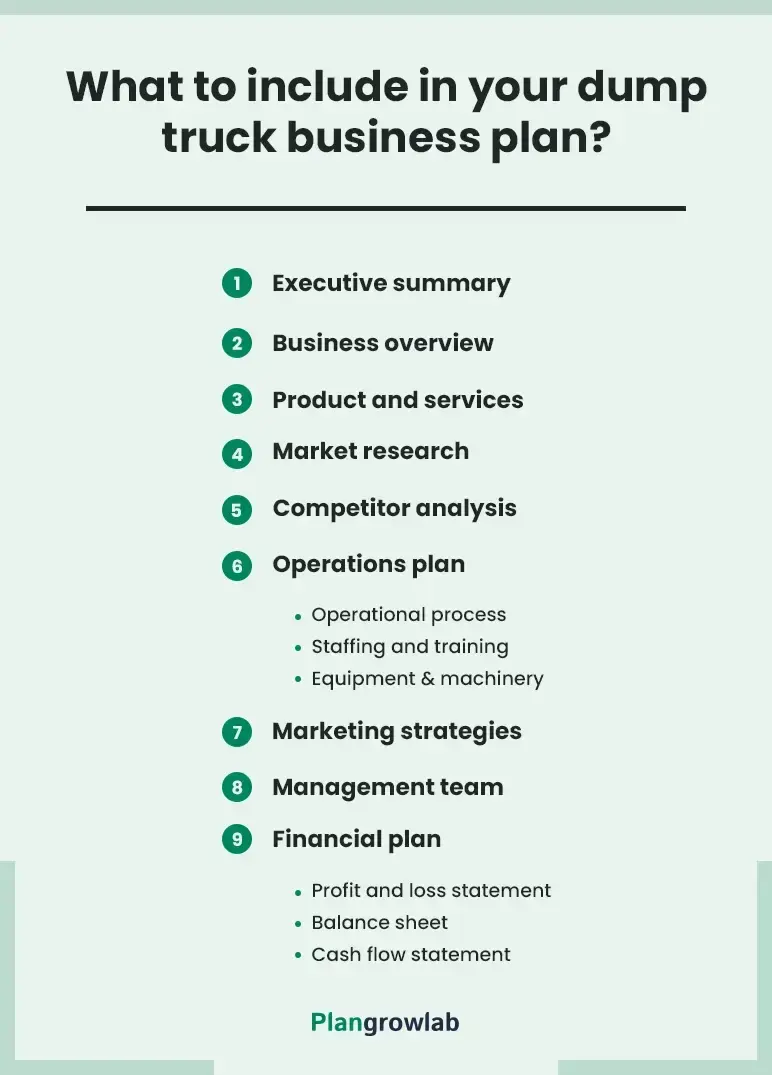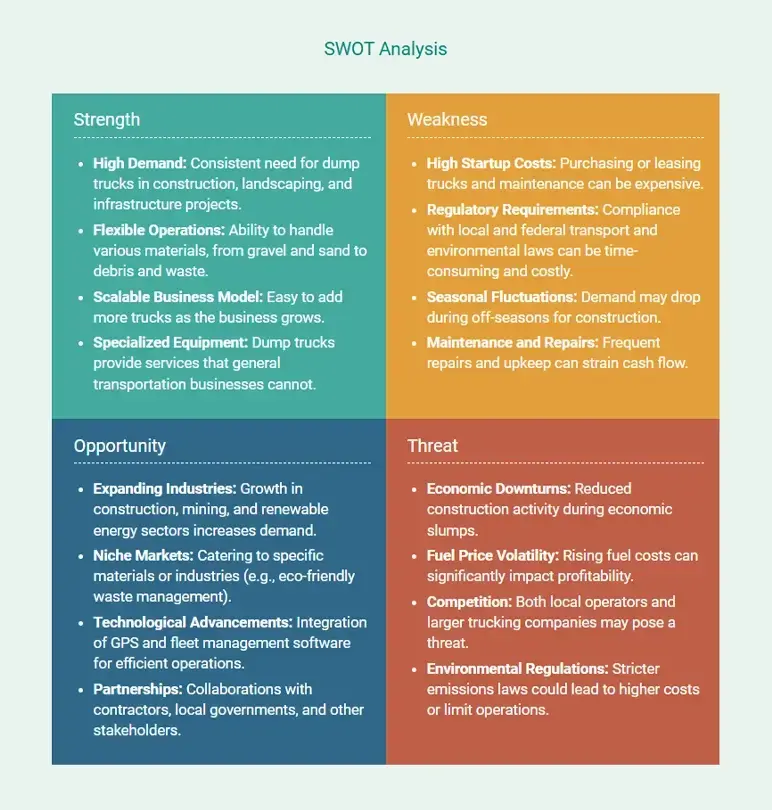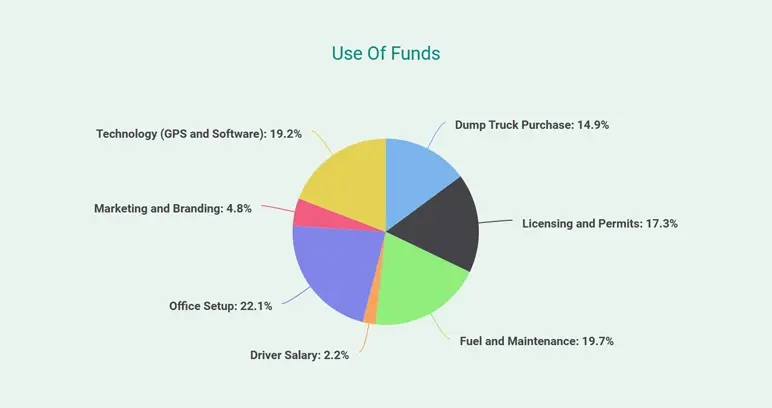Ever wondered how dump trucks go from moving dirt to making big money? Yeah, it might sound simple—get a truck, find a job, and start transporting. But without a solid plan, things can go wrong quickly.
That’s what Elissa Guillory, CEO at J Guillory Jr Trucking LLC, realized when she started her business.
When I spoke to her, she shared how a detailed business plan helped her grow from a single truck to a profitable fleet, learning from mistakes along the way.
This guide is based on that conversation. It helps you draft a winning business plan. But first…
What is a dump truck business plan?
A dump truck business plan is your blueprint for starting and managing a successful business. It defines your goals, the transportation services you’ll provide, and your target customers, such as construction companies or landscapers.
The plan also covers essential details like startup costs, truck maintenance, fuel expenses, and pricing strategies to ensure profitability.
Simply put, a solid dump truck business plan sets you up for success and keeps your business on the right track.
How does a dump truck business plan help?
A dump truck business plan is more than just a document—it’s your guide to building a successful and sustainable business. Here’s how it helps:
- Define your focus and decide between construction hauling, landscaping deliveries, or general transport services.
- Manage finances by breaking down expenses like fuel, maintenance, and insurance to plan your budget effectively.
- Identify target customers—contractors, landscapers, or municipalities—and strategies to attract them.
- Prepare you for growth by laying out steps to expand your fleet, hire truck drivers, or add services.
- Secure funding by simplifying getting bank loans or investments by detailing costs, revenue, and long-term goals.
In short, a business plan gives you clarity, keeps you organized, and helps you stay ahead in a competitive edge.
What to include in your dump truck business plan?
Here’s an easy, step-by-step guide to writing your business plan—just the essentials you need.

1. Executive summary
Think of the executive summary as your first conversation about your dump truck business. It’s a quick snapshot that shows what your business does and why it matters.
Start by describing your services and the industries you aim to serve. Highlight why your business is valuable to your clients.
Share your mission—what drives your business and the promise you deliver. Then, outline your vision for the future, like becoming a trusted leader or setting new industry standards.
Further, talk about your short-term and long-term goals, showing how they fit with your business's vision and helping your business grow and succeed over time.
Keep this section simple and on the point that leaves a strong impression.
“The executive summary for my trucking company was all about highlighting the essentials. I focused on explaining the core of the business—providing reliable hauling services for construction, landscaping, and other industries.
I made sure to include my target market, projected demand, and growth potential, keeping it short and to the point. It was more about painting a clear picture of the business opportunity than diving into too many details.”—Elissa Guillory
2. Business overview
Imagine someone asking, "What’s your business all about?" That’s exactly what the business description answers. This section dives deeper than the executive summary, giving readers a full understanding of your dump truck company.
Begin with an overview of your business. Share your name, where you’re based, and the industries you serve.
Next, outline your legal structure. Are you operating as a sole proprietor, LLC, or corporation? It’s a key detail that shows how you’ve organized your business for success.
Talk about your facilities. Do you have a central yard, office space, or specialized equipment? Highlight how your setup helps deliver seamless operations and excellent service.
If your business has history, share the milestones or moments that shaped it. If it’s new, focus on the passion and vision driving you forward.
“Writing the business overview was harder than I expected. I knew what I wanted to say, but putting it into words that made sense wasn’t easy.
I ended up just focusing on the basics—what we do, who we help, and why it matters. Once I kept it simple and clear, it all made sense.”—Elissa Guillory
3. Product and services
This section highlights the core of your business—what you offer, how it works, and why it matters. It’s where you show the value of your dump truck services and explain how they stand out in the industry.
Here’s an easy way to organize this section:
| Key Areas | What to Include | Why It Matters |
|---|---|---|
| Features and Benefits | List your services and their advantages | Shows value to customers |
| Quality Measures | Explain safety and maintenance efforts | Builds customer trust |
| Pricing Strategy | Share how you set fair prices | Ensures transparency |
You can also explain your unique selling point (USP) to showcase what sets your business apart, like eco-friendly practices or competitive pricing.
Even highlight the value your services bring by solving customer problems and improving efficiency.
“Writing about the services was straightforward. I detailed the types of hauling we’d offer—construction materials, landscaping supplies, and debris removal. I also highlighted additional services like scheduled deliveries and emergency hauling for last-minute needs.
Emphasizing reliability and flexibility was key because that’s what potential customers value most in this industry.”—Elissa Guillory
4. Market research
Market research is where you dive into the details of your dump truck industry and target customers. It’s about proving you know your market and how your business fits perfectly into the bigger picture.
First, identify the markets you plan to serve. Provide an overview of the dump truck market size and growth potential, showcasing how the industry is expanding and why this is a favorable time to enter.
Provide a brief explanation of TAM (Total Addressable Market), SAM (Serviceable Available Market), and SOM (Serviceable Obtainable Market) to give an idea of the market scope you aim to capture.
If required, conduct an effective SWOT analysis. It’s basically a quick look at your business’s Strengths, Weaknesses, Opportunities, and Threats. For instance:

Next, focus on customer analysis. Break down your ideal customers into segments, such as construction companies, landscapers, or government agencies. Explain their specific needs, preferences, and what they value most in a dump truck service.
Lastly, consider highlighting relevant dump truck industry trends, and show how these trends open up new opportunities for your business.
“Market analysis required some digging, but it helped me understand the local demand for hauling services. I looked at the growth in construction projects and landscaping businesses in the area.
Researching market trends showed me there was a consistent need for affordable and dependable dump truck services. This step helped me fine-tune my target audience and pricing strategy.”—Elissa Guillory
5. Competitor analysis
Even if your dump truck business is unique, there are likely other companies competing for the same customers. So, you have to identify those competitors.
To plan this section, note down how much traction they have in the market, whether through loyal client bases, strong branding, or partnerships.
Then, compare similarities and differences. Maybe you both serve the same industries but differ in pricing, customer service, or fleet size.
Highlight any edges you have, like eco-friendly practices, faster deliveries, or better technology. This helps investors see where you stand and why customers would prefer you.
“For competitor analysis, I identified other businesses in the area and studied their pricing, services, and customer reviews.
It helped me spot gaps—like the lack of 24/7 availability and eco-friendly disposal options—that I could use to stand out. This section made it clear how my business would compete effectively.”—Elissa Guillory
6. Operations plan
The operational plan section outlines how your business will function on a day-to-day basis and achieve its goals efficiently.
Here’s a list of key components to include in your operations plan:
- Operational process: Describe the step-by-step workflow, from customer requests to completing hauls and invoicing.
- Staffing and training: Outline required roles, like drivers and dispatchers, and training for safety, operations, and customer service.
- Equipment & machinery: List dump trucks and tools with plans for regular maintenance and upgrades.
- Product development: Highlight plans for new services, like eco-friendly transport or specialized hauling.
- Milestones: Define key goals, such as client acquisition, fleet expansion, or securing contracts.
“While writing the operations plan, I focused on how I’d run the business day-to-day. I outlined the fleet size, maintenance schedules, and safety protocols.
I also included logistics like driver hire, fuel costs, and route planning. Keeping it detailed ensured I had a clear roadmap for smooth operations from the start.”—Elissa Guillory
7. Marketing strategies
Your marketing strategies section outlines how you’ll market your services and attract customers. It’s like a roadmap for reaching your target audience and standing out in a competitive marketplace.
While drafting this section, consider including the different types of strategies—such as online ads, social media, and local partnerships—and explain why each method is relevant to your business.
Highlight the specific steps you’ll take, such as creating a professional online presence, using your fleet for branding, or offering customer promotions.
Be clear about how these strategies connect to your business goals. Include how you plan to measure success, whether by tracking website traffic, monitoring leads, or collecting customer feedback.
“For marketing, I planned to focus on local outreach and building partnerships. Networking with construction companies and landscapers was a top priority, as well as advertising in trade publications and local directories.
Social media platforms and a professional website would help showcase our services and build credibility.”—Elissa Guillory
8. Management team
The management team section explains who is leading the business and how key roles are connected to ensure success.
Begin with the owner’s background, showcasing relevant industry experience, expertise in logistics or operations, and key accomplishments. This demonstrates their capability to lead the business effectively.
Outline the roles and responsibilities of key team members and explain how each role supports daily operations and ensures smooth workflow.
Besides that, provide an overview of the organizational structure, detailing how decisions are made and communication flows within the team. Use a simple chart or description to make it clear.
If applicable, mention advisors or consultants, such as legal or dump truck industry experts, who will offer valuable guidance for strategic growth.
“Since I started small, the management team section was all about my own experience and qualifications.
I included my background in logistics and fleet management to show I had the skills to run the business. I also mentioned plans to hire experienced drivers and an operations manager as the business grows.”—Elissa Guillory
9. Financial plan
This section is like the heartbeat of your business plan—it’s where all your ideas come to life in numbers.
It shows how your business will generate income, manage overhead expenses, and grow over time, making it a crucial section for potential investors and stakeholders.
This plan gives a clear roadmap of your financial future for the next 3-5 years. Here’s what to include in your dump truck financial plan:
- Profit and loss statement
- Balance sheet
- Cash flow statement
- Break-even analysis
Make sure you are clear about how much funding you’ll need and how it will be used. Something like this:

A clear financial plan outlines how your dump truck business will handle expenses, generate profits, and achieve growth, giving investors a solid understanding of its potential.
“The financial plan was about making the numbers work. I calculated startup costs for trucks, insurance, and licensing, as well as ongoing expenses like fuel and maintenance.
Revenue projections were based on local demand and competitive pricing. Building in a buffer for unexpected costs gave me confidence in the plan.”—Elissa Guillory
Download free dump truck business plan template
Are you ready to draft your dump truck business plan but feeling unsure where to begin? Don’t worry—we’ve got you covered! Download our free dump truck business plan template in PDF format and get started today.
This easy-to-use template is crafted to help entrepreneurs like you organize your thoughts, outline business goals, and structure a plan easily. With practical examples, it simplifies the process and lets you cover all the essential details.
Get help writing your business plan
Now that you’ve gone through this guide, creating your new dump truck business plan should feel far more manageable.
If you need expert advice, our business plan consultants are here to help. From writing and reviewing your plan to tailoring it to your unique business, we support you to develop an investor-ready plan.
So, don’t wait—take the first step toward starting your dump truck business with confidence!
Frequently Asked Questions
Why do you need a business plan for a dump truck company?
A successful dump truck business plan serves as your roadmap for starting and growing your business.
It outlines your goals, target market, financial plan, and operations strategy, helping you stay focused and organized.
It’s essential for making informed decisions and demonstrating your business’s potential to stakeholders.
How much does a dump truck business plan cost?
The total cost of writing a dump truck business plan can range from as low as $7 (or even free) to $5,000 or more. It depends on the method you choose—using a DIY approach with templates, hiring freelancers or professional writers, or using business plan software.
For those on a tight budget, templates and examples specific to dump truck businesses are a cost-effective option.
What should you include in your dump truck business plan?
Your plan should cover the following sections:
- Executive summary
- Business overview
- Market research
- Competitors analysis
- Customer analysis
- Product and service
- Marketing strategies
- Operations plan
- Financial plan
Can a dump truck business plan help you secure funding?
Yes, a well-crafted dump truck business plan can help secure funding.
Detailed financial projections showcasing revenue streams and profit margins, along with market research highlighting industry growth, make a strong case for banks and investors.
A clear strategy for serving residential, commercial, or government clients further demonstrates that your business is positioned for success and profitability.

